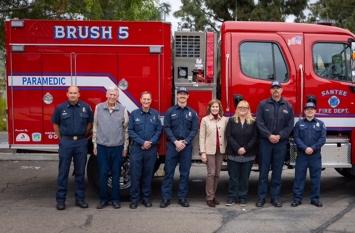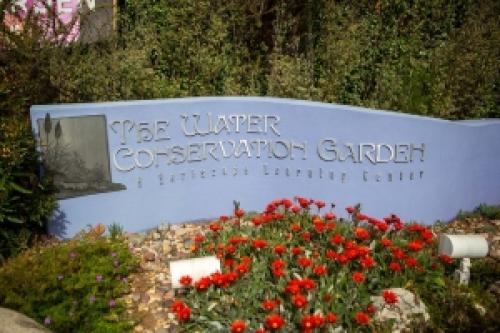

By Mike Allen
Photo: Members of Santee Fire Dept, SD Regional Fire Foundation and the SD River Conservancy with new brush rig funded through the city along with grants from the two nonprofits.
August 11, 2025 (Santee)-- The city of Santee has another key tool in its goal of protecting the city from wildfires, a new brush fire engine.
City officials and the public will get together Aug. 20 for a “push-in” ceremony at Station No. 5 to celebrate the new engine, which was paid mostly from nonprofit grants.
According to the city, the $627,000 fire engine made by HME Inc. was acquired thanks to a $407,000 grant from the San Diego Regional Fire Foundation, and the San Diego River Conservancy. The remainder came from the city’s general fund.

“It could happen, at any water system in the United States. The systems were not designed for what we what we witnessed in L.A.,” says Helix Water District general manager Brian Olney, though Helix has taken steps to reduce risk
By Karen Pearlman
March 20, 2025 (La Mesa) -- The city of La Mesa is being proactive on educating residents on emergency situations for water needs in case of out-of-control wildfires such as the January blazes that devastated Los Angeles County. Concerns about fires and lack of water to fight them led to elected officials in the city of La Mesa to have Helix Water District share insight and information about protection in a presentation at the March 11 City Council meeting.
By Yvette Urrea Moe, County of San Diego Communications Office
Video by José Eli Villanueva: prepare for a disaster with an emergency supplies kit, or “go bag.” When disaster strikes, often there are only a few minutes warning to evacuate. So, don’t wait until the warning comes, when you will likely be anxious and stressed, assemble your kit today and put it in a handy place to grab on your way out.
March 19, 2025 (San Diego) - Giving yourself and your family the best chance in a local disaster isn’t just about luck, it’s about planning and preparing for various hazards to lower injuries, deaths and perhaps even damages.
By Mike Allen
Photo by Scott Lagace: Santee firefighters saved the life of an unconscious woman during a July 2024 fire that engulfed her mobile home, also administering oxygen to save a cat.
March 14, 2025 (Santee) -- Santee knows it has to be better when it comes to providing fire protection to its residents, and after a sales tax-funded plan for new fire stations failed in November, its City Council made improving that essential service as its top priority.
In fairness, the Council was already focused on getting a couple of new stations to double the current number—two—to serve a population of more than 60,000.
It was building a temporary station off Olive Way where it formerly used to keep its maintenance operations, and was planning a new station in the north part of the city. Yet the Council was hoping the half-cent hike to local sales taxes would finance the improvements. Not so fast, said voters who rejected the plan.
At its March 12 meeting, the Council set building new fire stations—along with finding new ways to pay for them--as its No. 1 goal from a list of ten.
